#nancy bradfield
Text
Historical Costumes of England from the Eleventh to the Seventeenth Century
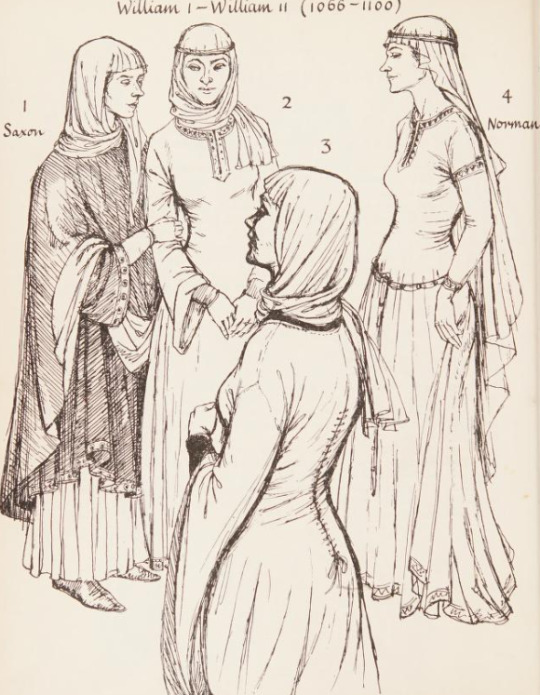
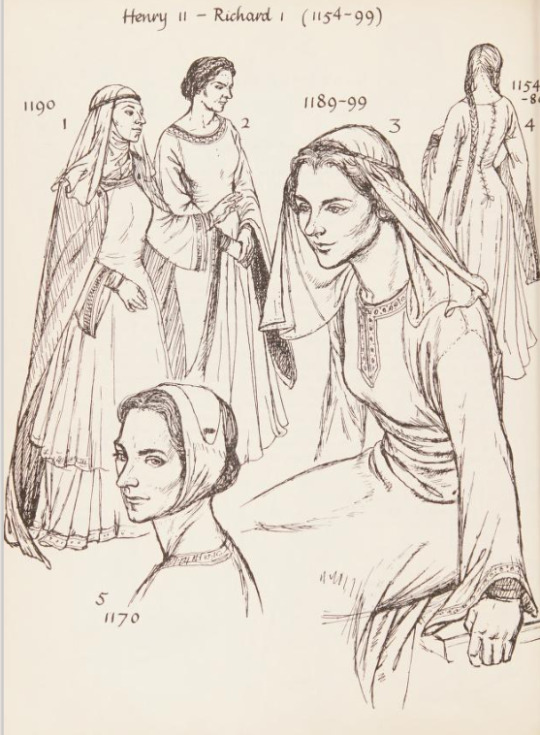
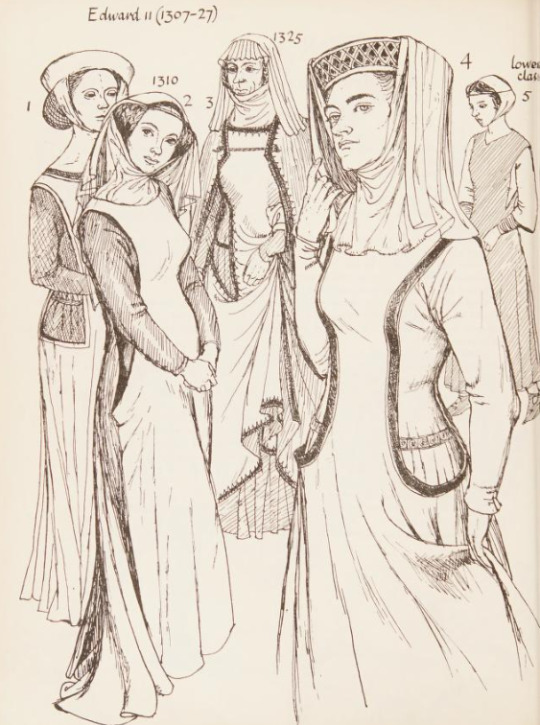
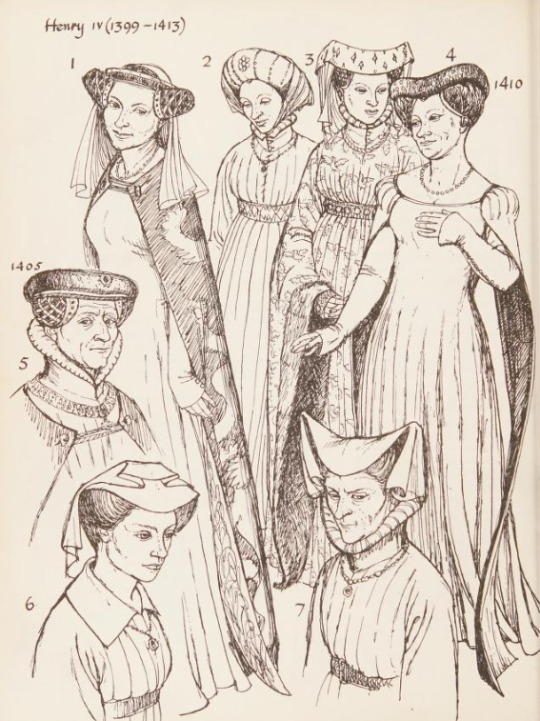
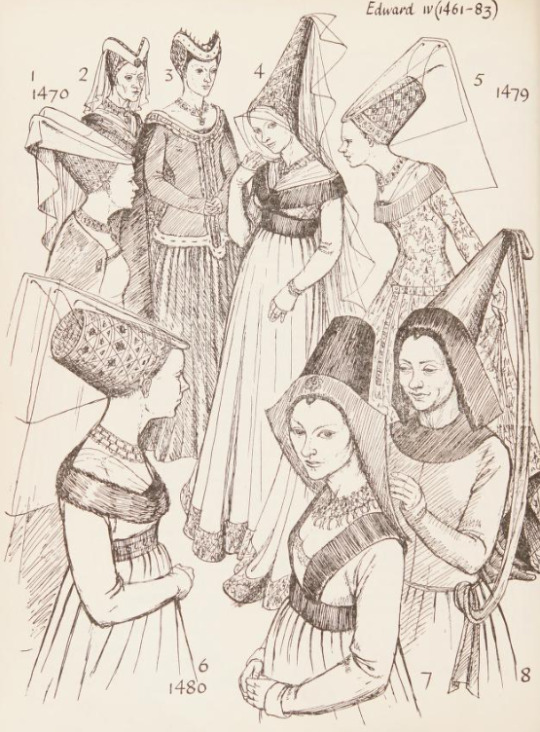

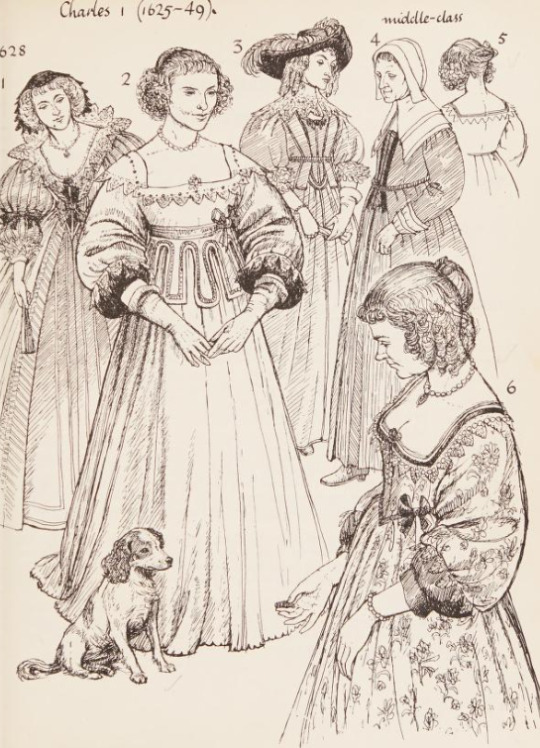
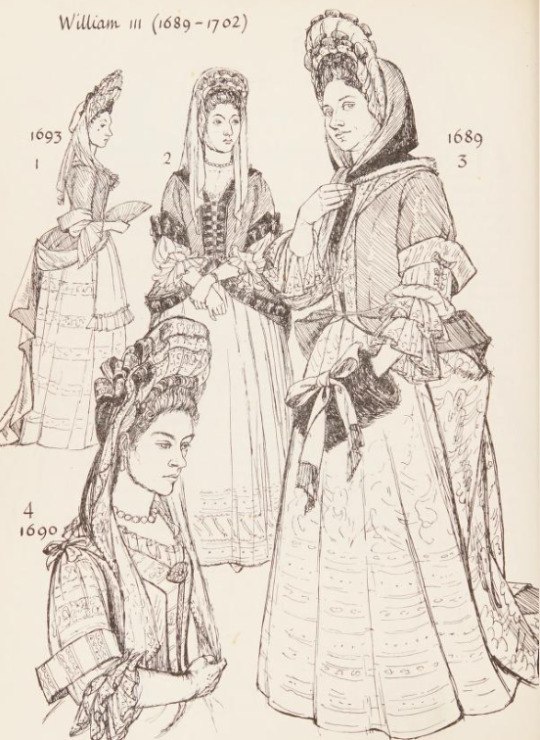
- Nancy Bradfield, 1963
283 notes
·
View notes
Text
Long Ago (and far away) Visual References
Because we didn't all haunt the library fashion history stacks as young people, I snagged some pics of visual references for the kinds of things Snape wears. I've definitely taken liberties since most of them are medieval women's clothes, but I like the sweep of the skirts better. And most medieval clothing didn't use the kinds of collars I've described on some of the under layers. And he doesn't wear veils.
When Severus is wearing something that's described as short-sleeved, this is the general idea (the Norman influence is from the Malfoys):

Although he does like a mitten sleeve that comes down to the knuckles, no matter what over-gown he may wear.
A shorter gown over a long one:

And really awesome sleeves (although this is for the fanciest possible iteration) plus a very fancy girdle:

All of the images are from Nancy Bradfield's Historical Costumes of England 1066 - 1968. It's one of my favorite resources since it also describes what was new in clothing during the period shown.
#long ago and far away#hp society/the ton#hp the season au#severus snape#hp the season/the ton au#visual reference for historic clothing
67 notes
·
View notes
Text
A (somewhat) Comprehensive List of Where and How I learn about Western Historical Costuming
I have made it no secret that I am deeply interested in history and, particularly, historical costuming. And though I understand it is a very niche topic that not many people are interested in, I do want to provide a list of sources that I find helpful for learning and writing about western historical costuming. From websites and books to youtube videos and extant garments and portraiture, I aim for this to be a guide for everyone, regardless of their preferred method of learning
Websites:
My main source for general overviews on historical costuming is fashionhistory, an excellent source for overall trends of a decade with a mixture of descriptions and visual references which I find incredibly useful
For a much more comedic and entertaining but still informative source, I’d recommend frockflicks as they’re very entertaining, often cover movie and tv show costumes and are generally a good read whilst still being informative and educational, you can really tell they know what they’re talking about
Youtube:
Though not my preferred source when writing about historical costuming, the beginning of my interest in historical costuming was through being recommended certain youtube videos and youtubers. As such, I want to recommend a few youtube channels that are valuable for learning about historical costuming, particularly if you are beginning to, or for simple entertainment value
Karolina Żebrowska is my all-time favourite costume youtuber, her videos are an excellent mix of educational and comedic and it was her content which sparked my interest in historical costuming. I will always recommend her because her videos are just chef’s kiss, incredible
Another very close second for me and someone else who also helped fuel my love for historical costuming is Bernadette Banner, she’s so eloquent and witty that her videos are so easy and enjoyable to watch for me, I highly recommend her
Another of my favourite costume youtubers is priorattire who does videos about the process of dressing in historical costuming as well as some other goodies! I find her videos useful when writing about the process of dressing and undressing and as a visual aid
Some other youtubers who I don’t regularly watch but are valuable nonetheless are Morgan Donner, Sewstine, Lady Rebecca Fashions, V. Birchwood, Samantha Bullat and many, many others I’m sure I’m forgetting
There are also a few channels that are more of a collective, usually in association with a museum or foundation such as English Heritage, CrowsEyeProductions and, of course, American Duchess
Books:
For writing specifically, I tend to reach for books more often than anything else, so here’s a few of my go-to books for writing about historical costuming
The v&a’s 18th Century Fashion in Detail and 19th Century Fashion in Detail are excellent visual references for the more intricate details of fashion, with images from extant garments
The Chronicle of Western Costuming by John Peacock is also an excellent visual reference with small descriptions which are quite useful and, if you’re specifically interested in English costuming, Nancy Bradfield’s Historical Costumes of England from the Eleventh to the Twentieth Century is also a good visual aid. On the topic of English costuming, Ian Mortimer’s ‘The Time Traveler’s Guide…’ series often contains descriptions on historical clothing which can be quite valuable and, if you’re like me and are into the very, very niche time period of 1660-1670 England, Liza Picard’s Restoration is so valuable for everyday life in London in the 1660s but also as a guide to clothing, with her detailed descriptions, it’s easily a go-to when writing about the restoration era
Extant Garments:
I don’t have much here since I only really visit the same two sources, that being The V&A and The Met Museum though The Kyoto Costume Institute is also incredibly useful
Those are all the sources I use regularly, as well as a range of ones that I don’t particularly but have used in the past, I hope this is valuable to at least someone and I fully encourage other people to share their own sources so that we can all learn something new about historical costuming
#not a reblog for once#froggi rambles#history#historical costuming#historical fashion#writing#one(1) mutual asked me for recommendations today and I'm making it everyone's problem#putting this under 'keep reading' for everyone's ease of mind#this'll probably change in a few months tbh but as of right now its good#i don't know if anyone's actually interested in this so#for future reference#so that it's at least of use to me
45 notes
·
View notes
Photo

In this festive season, enjoy this review of the Hull Little Theatre’s 1927 Christmas play, featuring Colin Clive in several roles quite different from those he would become famous for playing. From the Hull Daily Mail, published December 27, 1927. Transcript follows; apologies for the long text post but the article is very difficult to read in the clipping.
Feast of Fun and Fancy
“A Christmas Party” at the Little Theatre
All that a child could dream about the festive season is incorporated into “A Christmas Party,” which was produced at the Little Theatre, Hull, on Christmas Eve for a fortnight’s run. It is a charming show, brilliantly produced, and the work attached to the preparation of its innumerable delights must have been enormous. From the kiddies’ point of view the whole conception of the piece gives unalloyed delight, while the adult spectators will derive interested pleasure in watching the versatile efforts of artists usually associated with dark tragedy or subtle comedy. Personally, I found the show a thoroughly delightful entertainment, and the revival of the old Harlequinade (played by Colin Clive as Joey and Frederick Piper as Pantaloon) was a particular cause for enjoyment. The two actors, who emerged from a giant Christmas cracker, clowned their way through the second half of the programme with rare style, and their patter song about the Little Theater personalities was remarkably clever.
Contrary to custom this Christman party is not a pre-arranged one. It is the sudden thought of two children--Christopher and Evangeline--who are confined to their room with an attack of measles. Unable to join in the round of festivities themselves, they invite Santa Claus and the inhabitants of the toy cupboard to an impromptu party, and the result is absolutely amazing. Father Christmas makes a dramatic entry, in traditional fashion, and then the fun begins, waxing “furioser and furioser,” until it is time for everyone to go home. Patricia Bradfield, the clever young actress who was such a “hit” last season, makes a welcome return to play the part of Evangeline, while Merle Tottenham, another capable artist, acts skilfuly as the little boy. They sing and dance with charm, and their work has the requisite ingenuousness. As the host and hostess, they have a lot to do, particularly at the brilliantly arranged supper table, when the dolls become somewhat peevish and the Golliwog finds the lemonade going to his head. Father Christmas, splendidly played by Richard Fisher, also has to help to keep matters smooth.
Many of the people appeared in several characters. Edith Sharpe was a good-humoured, but garrulous Irish nurse, and a bold Robin Hood, and her songs were warmly applauded. As Anthony Rowley, the frog who would a-wooing go, Colin Clive was most engaging, and his energy as a Jack-in-a-Box was a source of wonder. Frederick Piper made a fine King Cole, and also a splendid toy soldier. In the latter character, Mr. Piper, in conjunction with Peggy Smith, who made an attractive doll, gave us an amusing dance, which was heartily encored. When the Three Blind Mice came in it took Colin Clive all his time to hold back the Cat, which Peter Taylor Smith played most convincingly. This actor took also the part of Mr. Noah and had a good partner in Millicent Jones, who sang in a pleasing fashion. The importation of a conjurer from China caused great excitement, and James Hudson executed some clever illusions which were greatly appreciated. The following also had interesting and amusing parts: Eva Jeafferson, Hilda Whatmore, Gwen Sibley, Ursula Granville, and Barry Barnes, while the following pupils of the Hull School of Music had small parts, and presented some skilful dances: Jessie Selle, Nancy Shores, Marjorie Simpson, Enid Grantham, Audrey Appleton, and Arthur Burrell.
The musical accompaniments were played by Mr. Dennis Boocock with rare sympathy and skill. --C.E.R.
4 notes
·
View notes
Text
"Whatever Shall I Wear?" Book Review
June 10, 2021

[Image ID: a photo of the cover of "Whatever Shall I Wear?", which is a parchment color and has a blue ink illustration of a late 18th-century woman.]
"Whatever Shall I Wear? A Guide to Assembling a Woman's Basic 18th Century Wardrobe" is exactly what the subtitle says it is - a solid foundation for assembling a working-class woman's 18th-century wardrobe. It was written by Mara Riley, illustrated by Cathy Johnson, and published in 2002. It's aimed specifically at reenactors, but I think it's appropriate for any historical costumer interested in this topic.
"Whatever Shall I Wear?" is a short book (not quite 50 pages), but it contains a LOT of information. It dedicates at least a page each to shifts, petticoats, pockets, stays, bed gowns, jackets, gowns, aprons, handkerchiefs, caps, hats, shoes, stockings, cloaks, hairstyles, and jewelry. And that's just the beginning.
There's a whole section on fabrics (fibers, colors, patterns, and piecing), plus a page on basic hand stitching. The book acknowledges that sewing machines make assembling garments faster, but encourages (not commands) using hand stitches for anything visible, which is a common method among many costumers today!
Being aimed specifically at reenactors, there are discussions about weathering your wardrobe and making it fit your persona, including tips for how to adapt to various cultural backgrounds (namely French, German, Scottish, and Irish, though it also discusses what enslaved Africans wore). It should also be noted here that some sections near the end use what is now considered a slur against the Romani people.
The book ends with an annotated reading list, divided by topic, and including some well-known books and authors, such as Janet Arnold, Nancy Bradfield, Norah Waugh, "Fashion in Detail" from the V&A, and more. There's also a short list of relevant merchants, some of which I know are still around today, like J.P. Ryan, Kannik's Korner, and Burnley & Trowbridge.
And the illustrations!!! Cathy Johnson, the illustrator, created wonderfully intricate ink drawings to illustrate the clothing described. She drew on (haha) paintings and engravings from the era as well as extant garments to showcase styles from throughout the 1700s.
Overall, "Whatever Shall I Wear?" is a great starting point for anyone who wants to understand what working-class women wore in the 18th century! The book can be bought from many online retailers that cater to 18th century reenactors, or directly from Cathy Johnson's website.
Stay warm. Stay safe. Stay healthy.
0 notes
Text
I mentioned a while ago that I'd been doing some online shopping - and the last book in my latest order finally came! Nancy Bradfield brought me a lot of joy as a teenager trying to learn how to write and world-build. This book is practically the origin of the 'shopping for a fanfic' tag on my Tumblr.
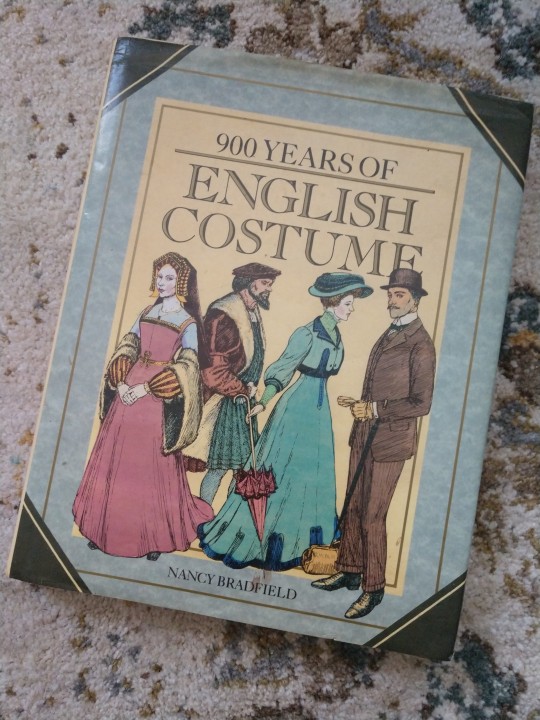


#i just love these illustrations!#nancy bradfield#historic dress#shopping for a fanfic#yes i was that kid
13 notes
·
View notes
Photo


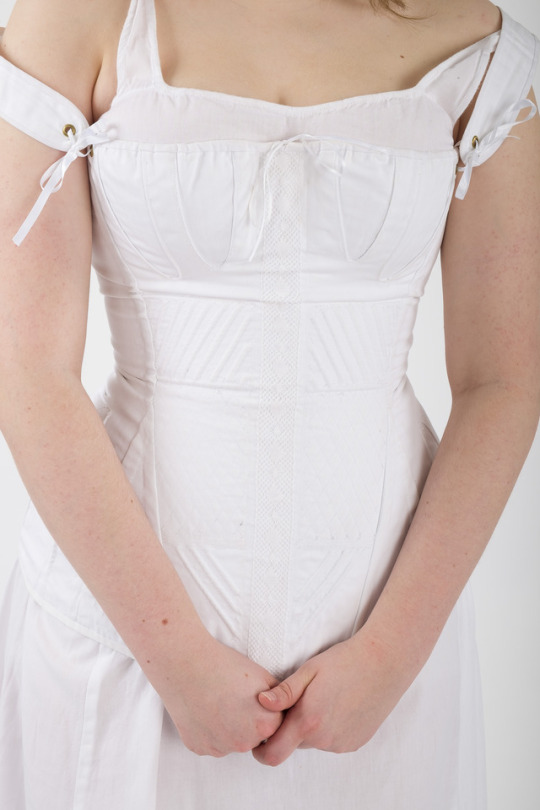

Hi, nothing new to post this week as i’m still very busy working as a Wardrobe Assistant on a Christmas show. I’m hoping to start up a few new projects after Christmas but for the time being here’s some more of my Regency Costume from my First Year of uni. Close up details of the dress as well as pictures of the corset (worn under the petticoat in these photos for modesty, as due to time constraints we didn’t make shifts). The corset is made from coutil with a layer of cotton for lining. It is decorated with quilting and cording which also provide support and the lace down the centre front is Torchon, designed and made by me. (The straps on the corset and petticoat could have done with being a little shorter). Thank You for 5,000 followers! (beep boop beep to the bots!)
#historic costume#historic fashion#Regency#1800s#1804#corset#corsetry#petticoat#gown#embroidery#buttons#cording#quilting#lace#lacemaking#torchon#nancy bradfield#costume in detail#coutil#cotton#muslin#5000 followers
246 notes
·
View notes
Photo


Costume in Detail 1730-1930, Nancy Bradfield
1 note
·
View note
Text
way back in the 80s my mom used to do costume design for theatre and she lends me this book sometimes, it's actually extremely useful for women's costumes (cover says it's 1730 -1930)
like, look at these (forgive me the quality but I can't scan the book cause the spine is all worn out)

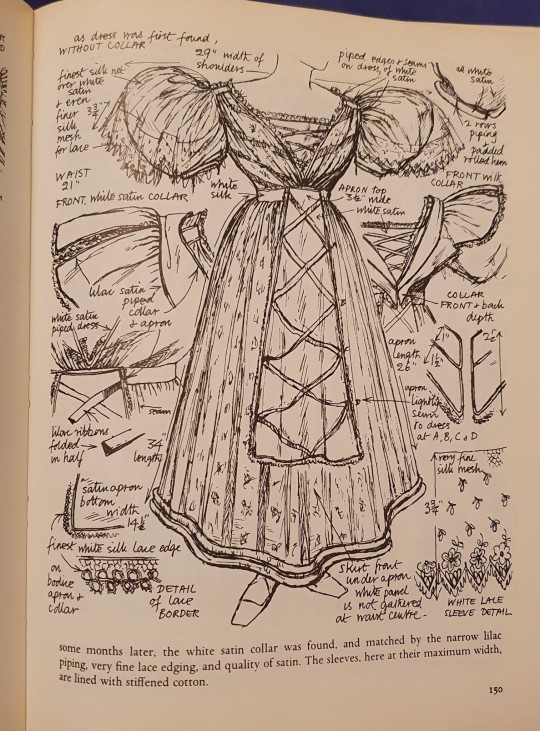
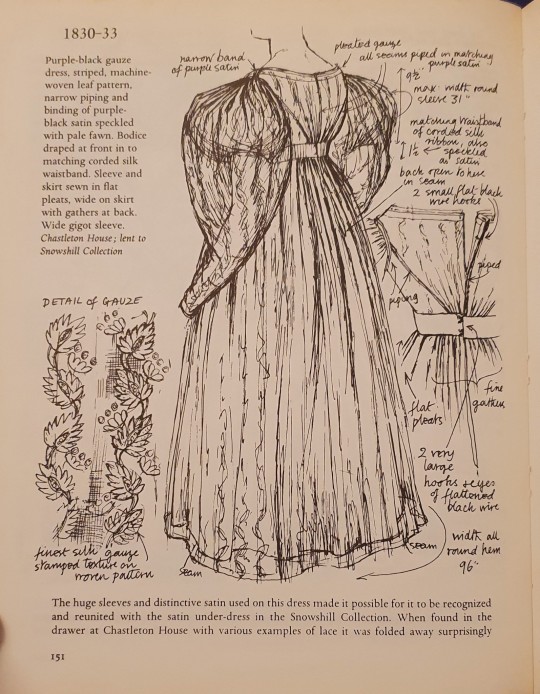
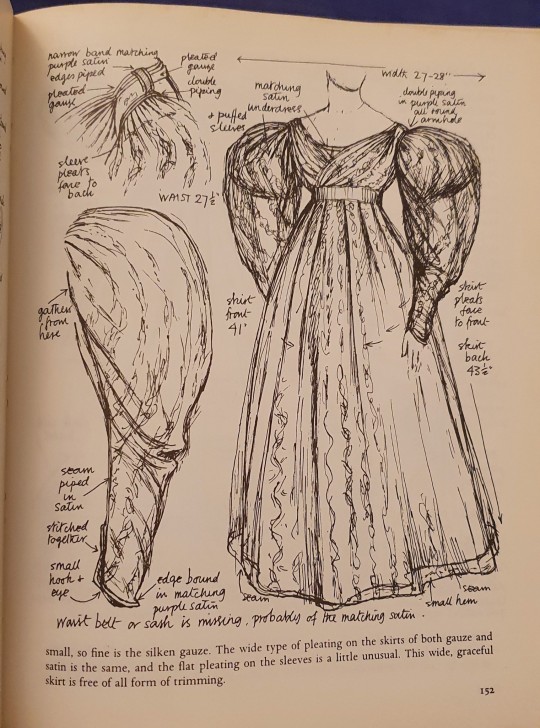



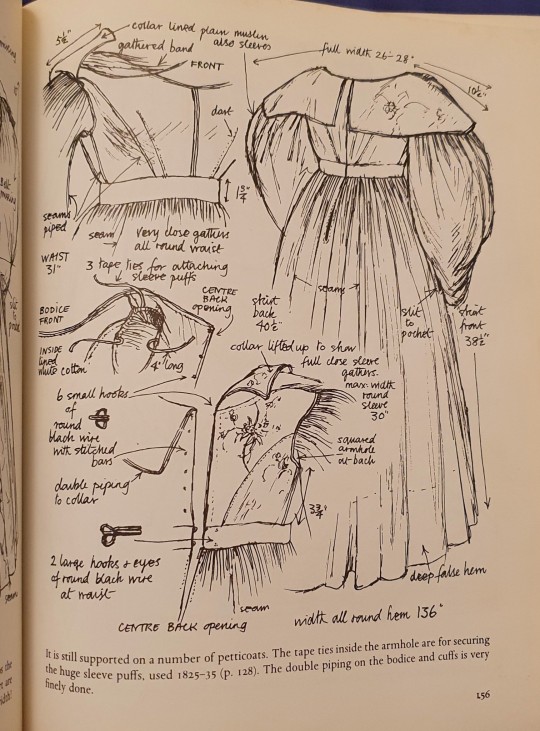
idk who wants to make these but here you go
EDIT: It's Nancy Bradfield's btw
2K notes
·
View notes
Text

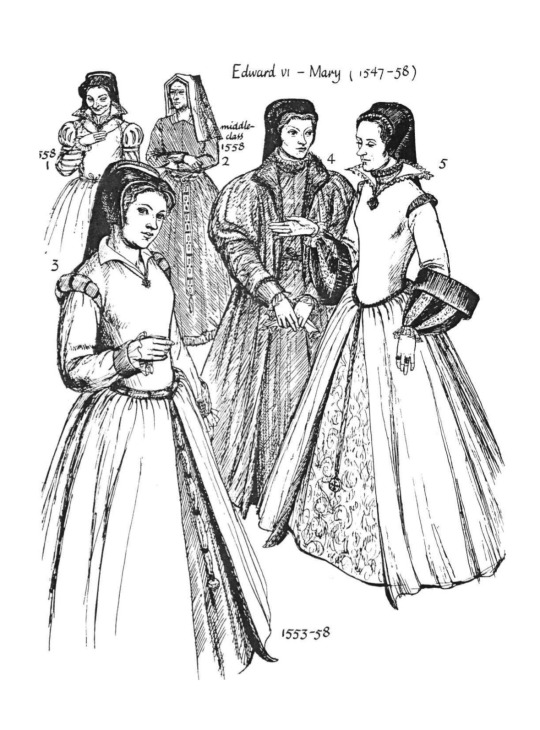

Tudor Women’s Fashion from the book Historical costumes of England: from the eleventh to the twentieth century By Nancy Bradfield
399 notes
·
View notes
Note
Luda anon. I don’t mind the nobility clothes either, tbh. I’m sure I can take them for inspo and describe them as being made of much cheaper and commonly used fabrics and styles based n what I already dug up. It would be much appreciated if you could dig something up even from the canon timeline
Hi there!
Sorry for having take this long to answer!
Okay, so... Luda. Since the Fold apparently has been up for 400 years, give or take, we're talking mid to late 1400's. The problem is that we do not really have extant garments, especially for lower class women, but let's see what we do know.
The gown with the tiny bodice, high waist, and full skirt was hardly altered; but the tight sleeves were now so long that they almost covered the hand. Though the high waist was more general, gowns with a low waist were sometimes seen; also for Court wear a low-waisted dress was worn, with a faint suggestion of the sideless surcoat—an echo of the fashion of 1350. A low, rounded neck sometimes replaced the deep V-shape of Figs. 2, 4, and on more simple dresses the round opening was sometimes filled in with a plain, dark material; square necks showing the top of the under-dress were quite common . Noblewomen wore damasks, many rich varieties of velvet, silks, and satin, also taffeta and soft woollen cloths. Coarser woollen cloths, frieze, flannel (of wool), russet, and linens were used by the poorer people.
Long, narrow, richly lined cloaks were worn with Court dress, and large circular cloaks were for general use, of velvet, broadcloth, frieze, and woollen cloths.
Women's Fashions (1460-83) from Nancy Margetts Bradfield: Historical Costumes of England
(All I could find of Russia at the time is that people probably worn European fashions?)
As a working woman, Luda probably wore things with a low waist. Since fabric is expensive (as it's all made by hand), her clothes were probably cut from rectangles to avoid wasting fabric as much as possible (lacing on the side/front of the dress is possible for a better fit).
As for the layers, as always, we start with a shift (most likely long sleeved) that protects the outer layers from body fluids. No underwear is worn under the shift at all (no drawers), only stockings, secured with garters (probably just a thin srtip of cloth). No boned supportive undergarments would have been worn (that's still a couple decades away). Then comes a kirtle, basically a dress--once again, simple in cut to save fabric, with long sleeves and a long skirt. After that comes another dress/kirtle, that we can also call a surcoat. As mentioned above, there was a sideless version of that (Harriet Walter wears a couple of sideless surcoats in the first season of The Spanish Princess as Margaret Beaufort--but please, do not use that show as a costume reference XD)
As for the hair, if we consider her Aleksander's wife/she had pose as his wife, historically speaking she is supposed to cover her hair with a kerchief/cap/veil, but the show showed her with unbound hair, and it's fantasy so...
As for colors, based on her scenes, her pallett seems to be based on greys and red (which then in turn mostly likely inspired the Healer uniforms), but undyed wool, browns and yellows also sound plausible. Her personal style is most likely very simple and unadorned, both out os need and practicality, but some embroidery is not unplausible.
Here's a vid on late 14th/early 15th century clothing:
youtube
This vid might be helpful too:
So... that's it. That's all I could dig up on my limited time XD However, I did start a tag for Luda, so some inspiration is due to start popping up :)
6 notes
·
View notes
Text

18th century mindset: WHERE IS MY BUTT??? How will the single men know I can bare children??????
Nancy Bradfield: 1911, corsets are worn under the petticoats and drawers; advertisements try to convince the feminine world that to be beautiful one must have no hips at all!
Me: Rip booty 😔
#sewing#historical costuming#edwardian fashion#historical fashion#the biggest joke here is i got a bf who loves my butt n i do not want to be a parent#my heart will go on
56 notes
·
View notes
Text
“it is impossible fully to understand any past age unless we are able to see it in the mind's eye clothed with some approximation to correctness, its houses furnished as they would have been furnished in actual fact, and its inhabitants clothed in costumes similar to those which they really wore”
From James Laver’s foreword from Nancy Bradfield’s ‘Historical Costumes of England from the Eleventh to the Twentieth Century’
#not a reblog for once#history#historical costuming#historical fashion#many many thoughts on this book and yet it’s so late at night#too late to really elaborate
19 notes
·
View notes
Text
Our Collective 18th Century Library
This is a selection of books about the 18th century fashion, history, beauty, and life. Most of them in my personal library or have consulted but have not bought (yet). This post is going to be edited with more books added and reblogged for all to see, that’s why I called this post “our collective 18th century library”, from me to you all and then for you all to all of us.
Please add other books you have in your collections or you’ve read! And if you could keep the format (cover photo, book info, a little comment, the themes we can find in the book, and the link of where to find them), it will be consistently useful for everyone!
Let’s start:
ART

Casta Painting: Images of Race in Eighteenth-Century Mexico, by Ilona Katzew, Yale University Press, 2005, ISBN-10: 0300109717
Casta painting is a whole genre created in Mexico for depicting the population of the New Spain, and it’s whole purpose was to show the Spanish King what an organised viceroyalty it was, and how everyone has their proper place, even if that was not entirely true.
Themes: fashion (for visual reference), castas, race, Mexico, New Spain, Viceroyalty, the Americas, Mexico City, art, 18th century.
Available at: Amazon / Barnes and Noble / Waterstones

Painted in Mexico, 1700-1790: Pinxit Mexici, edited by Ilona Katzew, Prestel Publishing, 2017, ISBN: 978-3-7913-5677-8
The book from the exhibition about art made in Mexico City during the 18th century.
Themes: art, portraits, casta painting, Mexico, Mexico City, Viceroyalty, New Spain, the Americas, castas, religion, catholicism, 18th century.
Available at: Amazon / Amazon (Spanish version) / Target / Waterstones
HISTORY
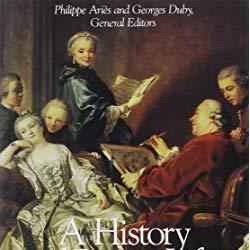
A History of Private Life, Volume III: Passions of the Renaissance, Edited by Roger Chartier, Series edited by Phillippe Ariès, Harvard University Press, 1993, ISBN 9780674400023
The life or ordinary people from the Renaissance to the Enlightenment, centered in Europe and especially France, you’ll read about the everyday lives of women and children, common men, education, marriage and well, the private life. This whole series (of 5 volumes) is worth each penny.
Themes: everyday life, history, women, Europe, France, children, education, Renaissance, Enlightenment, 16th century, 17th century, 18th century.
Available at: Amazon / Harvard University Press

A History of Private Life, Volume IV: From the Fires of Revolution to the Great War, Edited by Michelle Perrot, Series edited by Phillippe Ariès, Harvard University Press, 1993, ISBN 9780674400030
The first part is 18th century and deals with life pre, during and after French Revolution.
Themes: everyday life, history, women, Europe, France, children, education, Enlightenment, French Revolution, Victorian, Belle Epoque, WWI, 18th century, 19th century, 20th century.
Available at: Amazon / Harvard University Press

Black London: Life Before Emancipation, by Gretchen Gerzina, Rutgers University Press, 1995, ISBN-10: 0813522722
A glimpse into the lives of the thousands of Africans living in eighteenth century London.
Themes: everyday life, history, race, black, African, England, London, slavery, 18th century.
Available at: Amazon / You can also download it for FREE (ha! who needs Amazon now?)

Historia De La Vida Cotidiana En México 3: El siglo XVIII: entre la tradición y el cambio, by Pilar Gonzalbo Aizpuru, Fondo de Cultura Económica, 2012. ISBN-10: 9681677188
Common life in Mexico during the 18th century, from fashion, food and the markets, to the everyday life of mining cities, children and monks. This is book is a key reference for starting to read about the life of common people in the New Spain. Part of a series from the prehispanic times to the 20th century.
Themes: fashion, food, everyday life, New Spain, Mexico, Viceroyalty, The Americas, castas, mining, religion, catholicism, education, childhood, 18th century.
Available at: Amazon / Cambridge University Press / Fondo de Cultura Económica
FASHION

Auguste Racinet. The Costume History (Bibliotheca Universalis), Françoise Tétart-Vittu, Taschen, 2019, ISBN-10: 3836555409
I wanted to describe my undying love for this book, but I’m just gonna copy Taschen’s description: “Racinet’s Costume History is a landmark in the study of clothing and fashion. This reprint presents Racinet’s exquisitely precise color illustrations, as well as his delightful descriptions and witty commentary. From Eskimo attire to high French couture, this is an unrivalled encyclopedia for students, designers, artists, illustrators, and historians, and anyone interested in style.” So, yeah, this 19th century book rules.
Themes: fashion, interior design, furniture, 18th century, 19th century, fashion history, ancient times, middle ages, renaissance, baroque, rococo, victorian, menswear, womenswear.
Available at: Amazon / Taschen

Costume in Detail: 1730-1930, Nancy Bradfield, Quite Specific Media Group Ltd, 1999, ISBN-10: 0896762173
Focused on womenswear, Nancy Bradfield shares with all of us detailed illustrations and descriptions, as well as good information about fashion, garments, shapes, finishings, etc, of extant garments in private collections. A wonderful reference book for reproducing fashion and for illustrations or authors who want to give their character accurate fashion.
Themes: fashion,womenswear, extant garments, 18th century, 19th century, 20th century.
Available at: Amazon / Book Depository
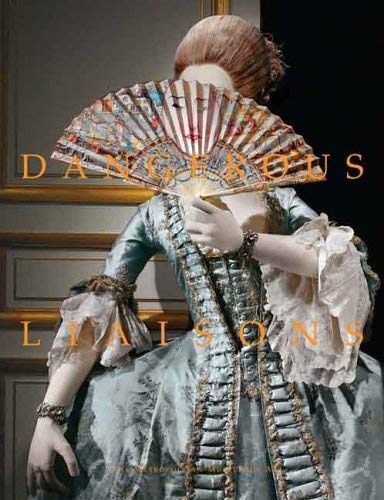
Dangerous Liaisons: Fashion and Furniture in the Eighteenth Century, by Harold Koda, Andrew Bolton, Mimi Hellman, Metropolitan Museum of Art 2006, ISBN-10: 0300107145
The book from a long gone exhibition at the Met Museum, it has extant clothes, good info, and the links between fashion and furniture design that make us perceive both as purely 18th century.
Themes: fashion, interior design, furniture, museum collections, extant garments, exhibition, 18th century.
Available at: Amazon / Metropolitan Museum of Art
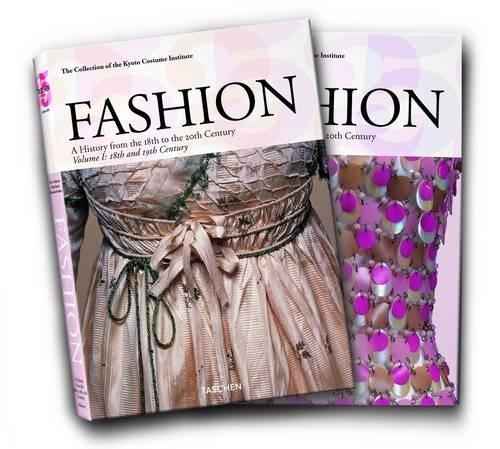
Fashion, A history from the 18th to the 20th century, by Akiko Fukai, Taschen 25th anniversary edition, 2007.
A basic fashion history book starting in the 18th century from the amazing collection of the Kyoto Costume Institute.
Themes: fashion, womenswear, menswear, embroidery, accessories, museum collection, extant garments, England, France, Europe, undergarments, 18th century, 19th century, 20th century.
Available at: Amazon in 1 volume and 2 volumes set.

Gallery of Late-Seventeenth-Century Costume: 100 Engravings, Caspar Luyken, Dover Publications, 2003, ISBN-10: 0486429865
Reprint of a collection of plates by Dutch engraver Caspar Luyken published in 1694. It shows men and women of different social classes and occupations. A key reference when looking for 17th century contemporary source material.
Themes: fashion, menswear, womenswear, Dutch, engraving, plates, 17th century, baroque, late 17th century, contemporary source.
Available at: Amazon / Dover Books

Historic Costumes and How to Make Them (Dover Fashion and Costumes), by Mary Fernald and Eileen Shenton, Dover Publications, 2006, ISBN-10: 0486449068
From the Middle Ages to the 19th century fashion, this book is a nice resource for theatrical costuming and has good but basic bits of historical fashion information. I recommend not to buy with no previous patternmaking and fashion background, since the diagrams are quite vague, and the descriptions even more. I personally only have used this book for reference of Medieval and early Renaissance fashion (which to be fair, are quite simple). Also, it is centered in English fashions.
Themes: fashion, theatre, menswear, womenswear, middle ages, renaissance, tudors, elizabethan, georgian, victorian, 15th century, 16th century, 17th century, 18th century, 19th century.
Available at: Amazon / Barnes and Noble / Dover Publications / Waterstones

How to Read a Dress, A Guide to Changing Fashion from the 16th to the 20th Century, Lydia Edwards, Bloomsbury Academic, 2017, ISBN-10: 1472533275
This books is very pretty and rather basic, it could be a really nice starting point for anyone getting an interest in fashion history. I’ve read reviews that it is “insultingly basic” which I do not get, I mean, if you cannot explain something in such a basic way that a child can get it, then you do not really master that subject. This books has pretty interesting info and it is a walkthrough of key silhouettes and extant garments, so it is not deeply detailed nor shows each and every silhouette of every decade of every century.
Themes: fashion, womenswear, gown, dresses, extant garments, museums, Europe, 16th century, 17th century, 18th century, 19th century, 20th century.
Available at: Amazon / Bloomsbury

Men's Garments 1830-1900: A Guide to Pattern Cutting and Tailoring, R. I. Davis and William-Alan Landes, Players Press, 1996, ISBN-10: 0887346480
A whole book only for menswear starting with the Regency silhouette and its very particular form until the turn of the 20th century. Yes. It is pretty good, I have to say, for all our Victorian outfit needs for the gentleman. I recommend this book (and the 2nd one on 19th and 20th centuries) for people with some knowledge of construction, grading, fitting, patternmaking, and tailoring, since it does not offer much sewing advice.
Themes: fashion, menswear, accessories, patternmaking, plates, 19th century, 20th century.
Available at: Amazon / Waterstones
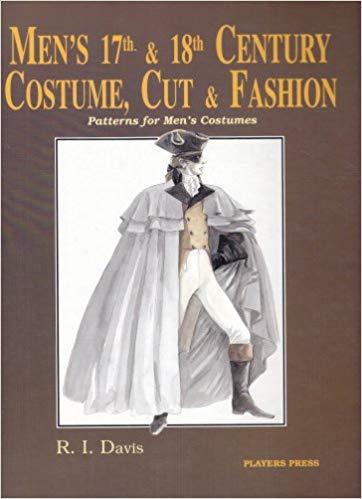
Men's Seventeenth & Eighteenth Century Costume: Cut and Fashion, R. I. Davis and William-Alan Landes, Players Press, 2000, ISBN-10: 0887346375
My personal love for menswear is fueled by this book that details the suits, coats and tailcoats from the 17th and 18th centuries. It includes military fashion and other everyday clothes like breeches, capes, waistcoats, etc. via plates, figures, diagrams and texts. I recommend this book (and the 1st one on 19th and 20th centuries) for people with some knowledge of construction, grading, fitting, patternmaking, and tailoring, since it does not offer much sewing advice.
Themes: fashion, menswear, accessories, patternmaking, plates, 17th century, 18th century.
Available at: Amazon / Book Depository
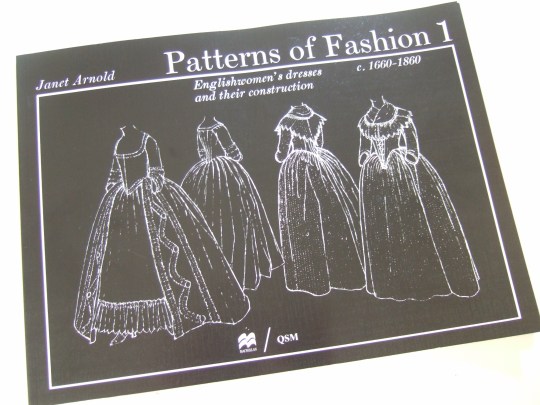
Patterns of Fashion 1: Englishwomen's Dresses and Their Construction C. 1660-1860, by Janet Arnold, Drama Publishers, 2005, ISBN-10: 9780896760264
THE key source of patterns of extant garments, this series of books are the result of constant research on garments from museums, with details and info on construction, history and fashion details. You know, the kind of information you could only get with those garments in your hands.
So, as a resume, in this list there’s only the books with 18th century info in them, BUT you should actually have ALL of the Patterns of Fashion books.
Themes: fashion, womenswear, England, extant garments, museums, Europe, patternmaking, 17th century, 18th century, 19th century.
Available at: Amazon
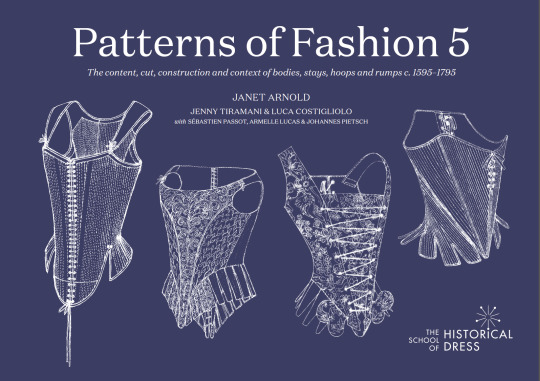
Patterns of Fashion 5: the content, cut, construction & contexto of bodies, stays, hoops & rumps, c 1595-1795, by Janet Arnold, Jenny Tiramani, Luca Costigliolo, Sebastien Passot, Armelle Lucas and Johannes Pietsch, The School of Historical Dress, 2019
The new book from the series is about undergarments from the 16th to the 18th century. It is only available through the store of the School of Historical Dress. Probably the best spent £35.
Themes: fashion, undergarments, stays, womenswear, England, extant garments, museums, Europe, patternmaking, 16th century, 17th century, 18th century.
Available at: The School of Historical Dress

Pictorial Encyclopedia of Historic Costume: 1200 Full-Color Figures, Karl Rohrbach (Author), Albert Kretschmer (Compiler), Dover Fashion and Costumes, 2007, ISBN-10: 0486461424
A reprint of Die Trachten Der Völker from 1906, this book, this is a great great encyclopedic work of fashion history, from ancient Egypt to late 19th century. It includes clothes for people of different social backgrounds, accessories, jewels, shoes, etc. I think that for the fashion history lover, the Rohrbach+Racinet combo is a must.
Themes: fashion, interior design, furniture, 18th century, 19th century, fashion history, ancient times, middle ages, renaissance, baroque, rococo, victorian, menswear, womenswear.
Available at: Amazon / Dover Publications
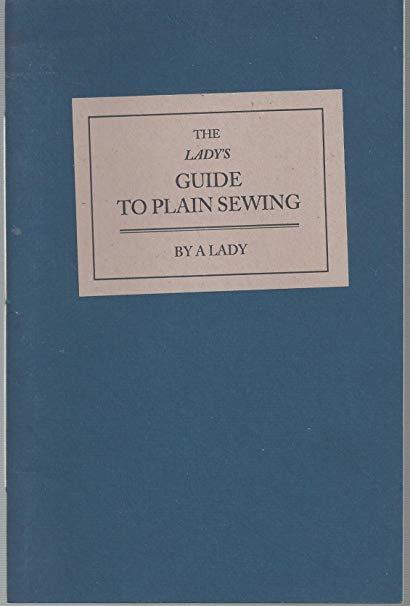
The Lady's Guide to Plain Sewing, Book I, Kathleen Kannik, ISBN 10: 0-9640161-0-9
References and tips for plain hand sewing, a key reference to achieve basic stitches that are historically accurate. It includes basic construction of items and some decorative techniques. Many of these techniques are still used in couture. This book is part 1 of a set of 4.
Themes: fashion, undergarments, womenswear, menswear, sewing, stitches, techniques, how to, patternmaking, 17th century, 18th century, 19th century, 20th century, couture.
Available at: Kannik’s Korner / Amazon (kindle edition) / Amazon

The Lady's Guide to Plain Sewing, Book II, Kathleen Kannik, ISBN 0-9640161-2-5
More sewing stuff with additional stitches and seam techniques, gather attachments, button making, gussets, re-enforcements, cord making, and an 18th century alphabet for cross stitching. This book is part 2 of a set of 4.
Themes: fashion, undergarments, womenswear, menswear, sewing, stitches, techniques, how to, patternmaking, 17th century, 18th century, 19th century, couture.
Available at: Kannik’s Korner / Amazon
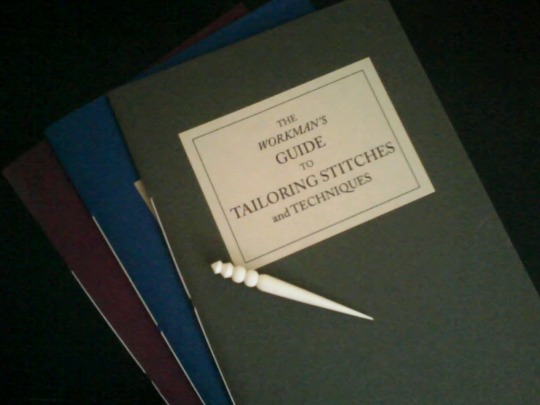
The Workman's Guide to Tailoring Stitches and Techniques, Kathleen Kannik, ISBN 0-9640161-4-1
Now it’s time for historical tailoring stitches and techniques. This book is part 3 of a set of 4.
Themes: fashion, tailoring, menswear, sewing, stitches, techniques, how to, patternmaking, 17th century, 18th century, 19th century.
Available at: Kannik’s Korner / Amazon

The Lady's Economical Assistant or, The Art of Cutting Out, and Making, The most useful Articles of Wearing Apparel, Without waste; Explained by the Clearest directions, and Numerous Engravings, of Appropriate and Tasteful Patterns, ISBN 0-9640161-3-3
A re-drawn publication of a 1808 book, with cutting directions and patterns for infant clothes, girls, boys, some for men and women, and linens. Many illustrations and a supplement. This book is part 4 of a set of 4.
Themes: fashion, undergarments, kidswear, children, babies, infants, womenswear, menswear, sewing, stitches, techniques, how to, patternmaking, 17th century, 18th century, 19th century.
Available at: Kannik’s Korner / Amazon

The American Duchess Guide to 18th Century Dressmaking: How to Hand Sew Georgian Gowns and Wear Them With Style, by Lauren Stowell and Abby Cox, Page Street Publishing, 2017, ISBN-10: 1624144535
This book is such a good starting point for a 18th century wardrobe, since it walks you through the key outfits of the century in a simple and clear way. I think a background in patternmaking is a plus, especially for the most complex projects, but the basics are easy to follow.
Themes: fashion, patternmaking, how to, womenswear, 18th century.
Available at: Amazon / American Duchess
BEAUTY

18th Century Hair & Wig Styling: History & Step-by-Step Techniques, Kendra Van Cleave, Nice One, ISBN-10: 0692220437
Kendra van Cleave have been everyone’s guide into the 18th century beauty and hair (and of course, costuming) for quite a long time, thanks to her blog, Démodé, and now she published this well researched book with easy to follow instructions for all kinds of 18th century hairstyles. So, go get your wig and get to work. Also, at the book’s website there some videos, and at her blog you can find even more resources, tutorials, etc.
Themes: fashion, beauty, hair, wigs, 18th century, how to.
Available at: Amazon / 18th Century Hair Website

The American Duchess Guide to 18th Century Beauty: 40 Projects for Period-Accurate Hairstyles, Makeup and Accessories, by Lauren Stowell and Abby Cox, Page Street Publishing, 2019, ISBN-10: 1624147860
I KNOW this is not available yet, but I think it will be at least as good as the fashion one. Already on my pre-order list, it will be available on July 9th.
Themes: hair, hairstyles, hair and makeup, makeup, accessories, how to, womenswear, 18th century.
Available at: Amazon / American Duchess
#sometimes I write stuff#books#my 18th century library#or something#18th century#fashion#history#beauty
623 notes
·
View notes
Text
@geekmonkeyscience thank you for tagging me in this!
10 books I want to read in 2020:
• “A Writer's Diary” - Virginia Woolf
• “How To Be a Victorian” - Nancy Bradfield
• “The Ladies Of Llangollen” - Elizabeth Mavor
• “The Victorian Age in Literature” - G.K. Chesterton
• “The Witch-Hunt in Early Modern Europe” - Brian P. Levack
• “Down Girl: The Logic of Misogyny” - Kate Manne
• “Why do women write more letters than they post?” - Darian Leader
• “Paradise Lost” - John Milton
• “Ten Days in a Mad-House” - Nellie Bly
• “Tell Me I'm Forgiven: The Story of Forgotten Stars Gwen Farrar & Norah Blaney” - Alison Child (if I manage to get a hold of it, which apparently it's not easy)
wow, all non-fiction, okay, okay...
tagging: @guardianrock @flozmin @rathersleep @kait-e-k @mjsburgh hope you have some fun with this!
#personal#the last one oh how I want the last one#fuuuuuuuu#I really hope I get around to read them all#what a list#what a gay list is this?#god#my thing is lesbians in older times
13 notes
·
View notes
Link
not trans specific, but wardrobe options.
Bernadette Banner
Published on Mar 2, 2019
I accidentally wrote an essay whilst researching for my corset project, so enjoy. Stay tuned for the actual making adventures of said corset.
More interesting analyses on corset myth things:
"Busting Corset Myths" on Foundations Revealed: http://foundationsrevealed.com/articl…
“The Edwardian Silhouette Emerges” by Cathy Hay https://thepeacockdress.com/2015/02/t…
SOURCES
Arnold, Janet. “Patterns of Fashion 2: Englishwomen’s Dresses & Their Construction C. 1860 - 1940”, 1982.
Bradfield, Nancy. “Costume in Detail: Women’s Dress 1730-1930”, 1968. Flower, B. O. “Fashion’s Slaves.”, 1892. https://archive.org/details/fashionss…
Flower, William Henry. “Fashion in Deformity”, 1881. https://play.google.com/books/reader?…
Kim, Alexandra and Mida, Ingrid. “The Dress Detective”, 2015. Langley Moore, Doris. “The Woman in Fashion”, 1949.
O’Followell, Ludovic. “Le corset; histoire, médecine, hygiène”, 1908. https://catalog.nyam.org/cgi-bin/koha…
Schwarz, G. S. “Society, physicians, and the corset”, 1979. https://www.ncbi.nlm.nih.gov/pmc/arti…
Steele, Valerie. “The Corset: A Cultural History”, 2003. Thomas, Theodore Galliard. “A Practical Treatise on the Diseases of Women” (6th edition) 1892 https://books.google.com/books?id=3OH… (specifically the heading ‘Impracticalities of Dress’)
The Toronto Daily Mail issue dated 5th May, 1883. https://news.google.com/newspapers?id… Measurement chart taken from ‘details’ on this dress: https://www.forever21.com/us/shop/cat…
#not trans specific#feminine wardrobe#wardrobe#corsets#bras#transfeminine resources#mtf resources#mtf#history#YouTube
11 notes
·
View notes